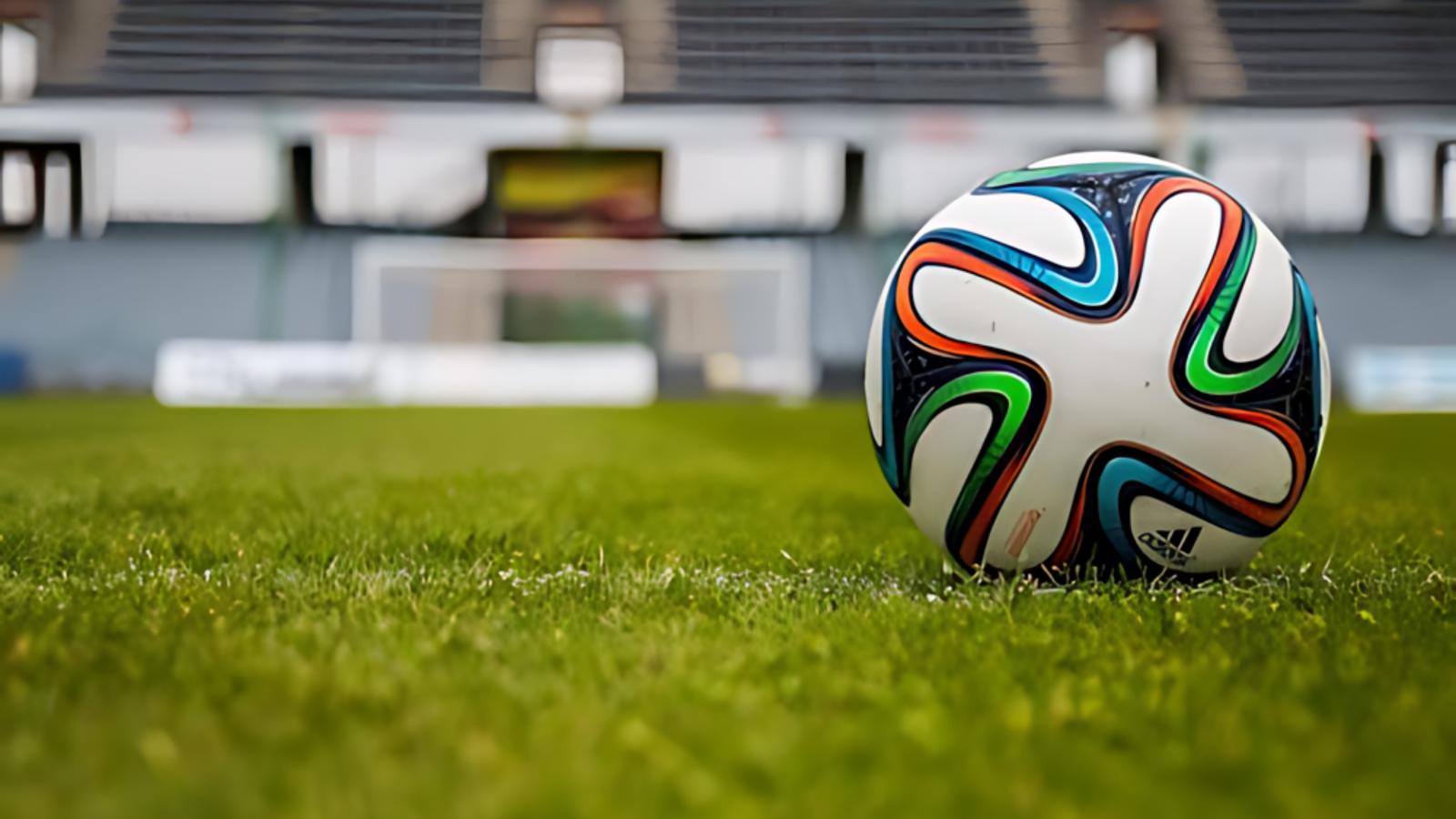
Everything that regards the best performing class, safety, and enjoying practicing Football Size for Adults match depends on the class and the age of the people and characteristics of the ball. Here is the breakdown on the various sizes of football, the size measurements and some recommended usage size options.
Official Size and Measurements
Size 5 Football
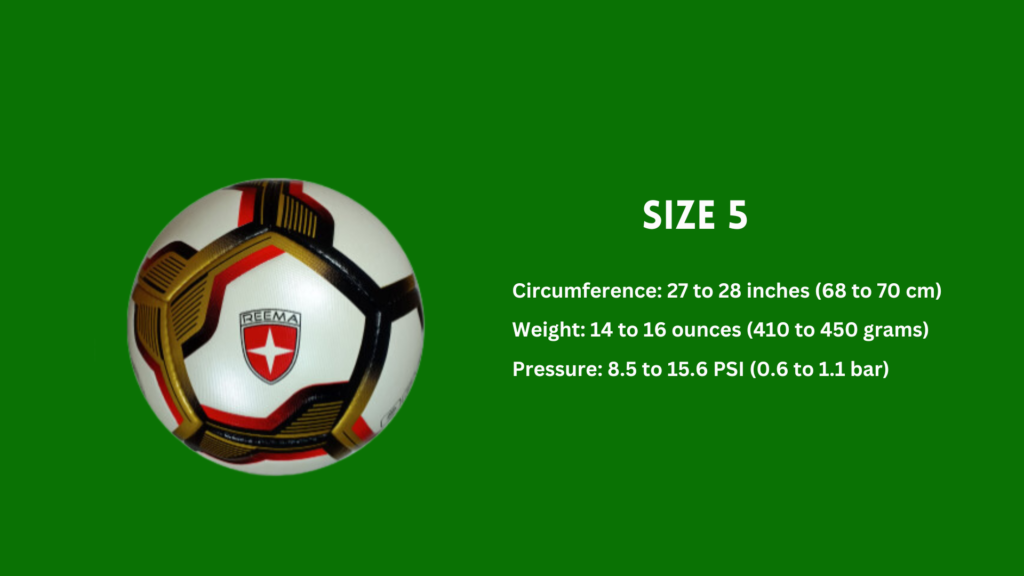
A 5-size football has a circumference between 27 and 28 inches (68-70cm), weighing from 14 to 16 ounces (410-450 grams). Both professional and adult leagues employ this size ball.
Circumference: 27 to 28 inches (68 to 70 cm)
Weight: These items should ideally have skin removed and be weighed at approximately 14 to 16 ounces, which is 410- 450 gm.
Pressure: 8.5-15.6 PSI (0.6-1.1 bar)
Usage: In practically all international adult and professional football games, this is likely the most prevalent size. This is for the games intended for professionals, and is meant to be the most amendable, stable, and interactive.
| Size | Length | Height | Upper Width | Lower Width |
|---|---|---|---|---|
| 24 x 8 ft | 24 ft / 7.3 m | 8 ft / 2.4 m | 5 ft / 1.5 m | 8.2 ft / 2.5 m |
| 12 x 6 ft | 12 ft / 3.6 m | 6 ft / 1.8 m | 1.6 ft / 0.5 m | 4 ft / 1.2 m |
| 10 x 6.5 ft | 10 ft / 3 m | 6.5 ft / 2 m | 3.2 ft / 1 m | 4.9 ft / 1.5 m |
| 8 x 6 ft | 8 ft / 2.4 m | 6 ft / 1.8 m | 1 ft / 0.3 m | 4.9 ft / 1.5 m |
| 6 x 4 ft | 6 ft / 1.8 m | 4 ft / 1.2 m | 1 ft / 0.3 m | 2.6 ft / 0.8 m |
| Aspect | Measurement |
|---|---|
| Circumference | 27 to 28 inches (68 to 70 cm) |
| Weight | 14 to 16 ounces (410 to 450 grams) |
| Pressure | 8.5 to 15.6 PSI (0.6 to 1.1 bar) |
| Usage | Standard size for adult and professional football matches |
| Design Benefits | Optimal control and balance for adult players; Consistency and fairness in competitive play |
Size 4 Football
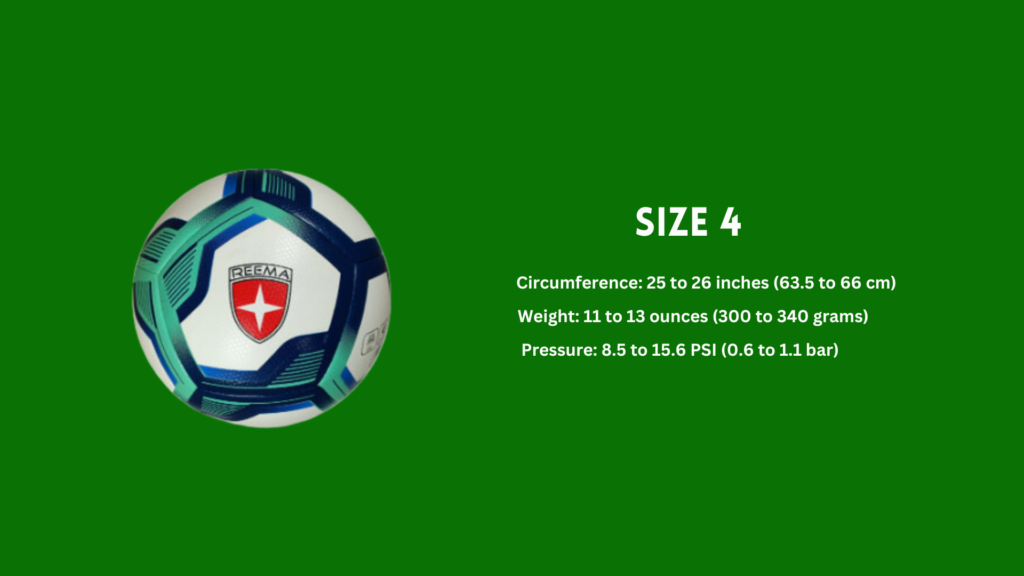
A Size 4 football is to the circumference 25 to 26 inches and weighs 11 to 13 ounces. It is used for youth matches; that is, matches including children between 8 and 12 years old, and also for the training of adults. Its size is that it can be used as an auxiliary training device with practicing handing and control.
Circumference: 25 to 26 inches (63.5 to 66 cm)
Weight: 11 to 13 ounces (300 to 340 grams)
Pressure: 8.5 to 15.6 PSI (0.6 to 1.1 bar)
Use: The Size 4 balls are mostly used in youth matches which are aged between 8 to 12 years, but it can also be used by adults in practice since it will hone their skills of ball handling and control. Players can make use of these balls in drill formats that are not competing in nature…
| Aspect | Measurement |
|---|---|
| Circumference | 25 to 26 inches (63.5 to 66 cm) |
| Weight | 12 to 13 ounces (340 to 370 grams) |
| Pressure | 8.5 to 15.6 PSI (0.6 to 1.1 bar) |
| Usage | Ideal for youth and intermediate players |
| Design Benefits | More manageable for younger players; Helps develop basic skills; Suitable for developing control and passing |
Size 3 Football
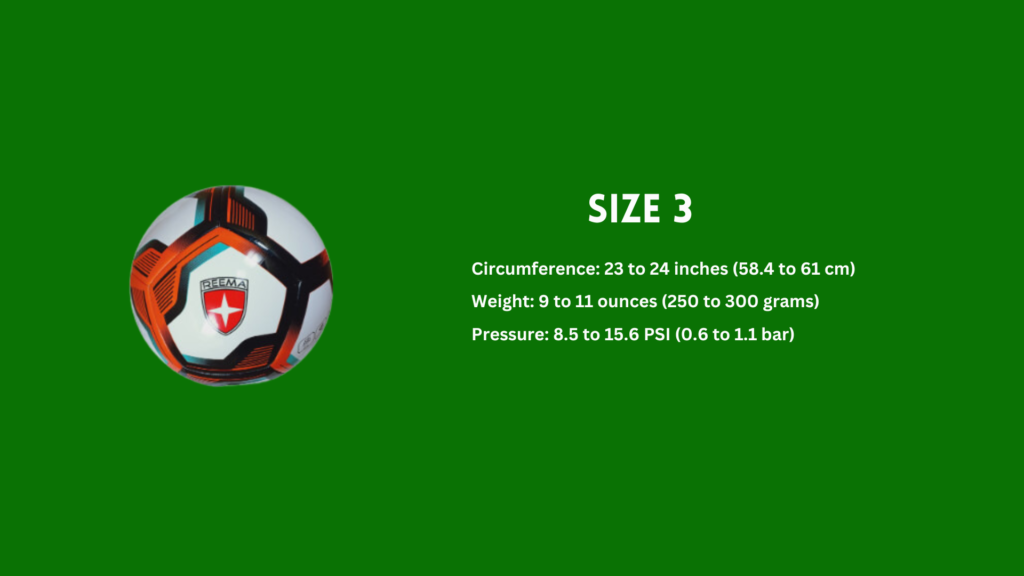
A Size 3 football has a circumference of 23 to 24 inches (58.4 to 61 cm) and weighs 9 to 11 ounces (250 to 300 grams), primarily used for younger children to develop basic skills. This size is not typically used in adult matches but can be beneficial for early-stage training focused on fundamental techniques.
| Aspect | Measurement |
|---|---|
| Circumference | 23 to 24 inches (58.4 to 61 cm) |
| Weight | 9 to 11 ounces (250 to 300 grams) |
| Pressure | 8.5 to 15.6 PSI (0.6 to 1.1 bar) |
| Usage | Designed for children ages 8 and under |
| Training Tool | Used for dribbling, passing, and shooting skills |
| Benefits | Easy to control and kick; supports skill development for young players |
Circumference: 23 to 24 inches (58.4 to 61 cm)
Weight: 9 to 11 ounces (250 to 300 grams)
Pressure: 8.5 to 15.6 PSI (0.6 to 1.1 bar)
Usage: Size 3 balls are mainly used for younger children and are not typically suitable for adult matches. They are often used in early development stages to help young players learn basic skills.
Choosing the Right Size
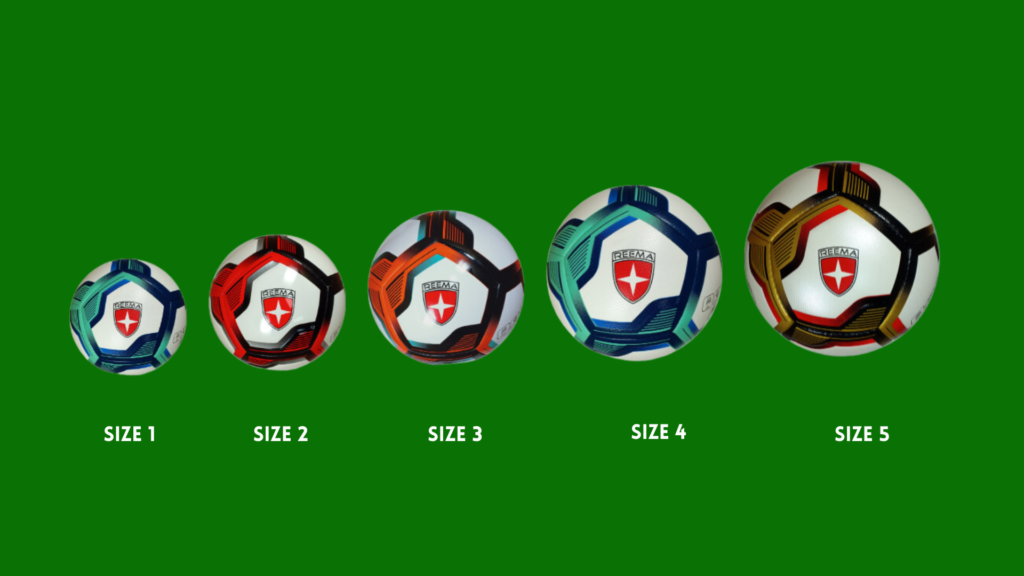
Importance of Size 5 for Adults
For adult players, using the Size 5 football is essential for official matches and competitive play. This size is standardized by FIFA and other governing bodies to ensure consistency and fairness in the game.
| Aspect | Details |
|---|---|
| Circumference | 23 to 24 inches (58.4 to 61 cm) |
| Weight | 9 to 11 ounces (250 to 300 grams) |
| Pressure | 8.5 to 15.6 PSI (0.6 to 1.1 bar) |
| Usage | Primarily designed for younger children, typically ages 8 and under, to help them develop basic football skills. |
| Training Tool | Often used in training sessions to focus on fundamental techniques such as dribbling, passing, and shooting. |
| Not Common in Adult Matches | Not typically used in adult or competitive matches due to size and weight differences from standard balls. |
| Benefits | Smaller size and lighter weight make it easier for young players to control and kick, fostering confidence and skill development. |
Performance: A Size 5 ball is designed to match the strength and skill level of adult players, providing the best balance, control, and responsiveness.
Skill Development: Playing with the correct size ball helps players develop their skills more effectively, as they learn to control and maneuver a ball that is appropriate for their level.
When to Use Smaller Sizes
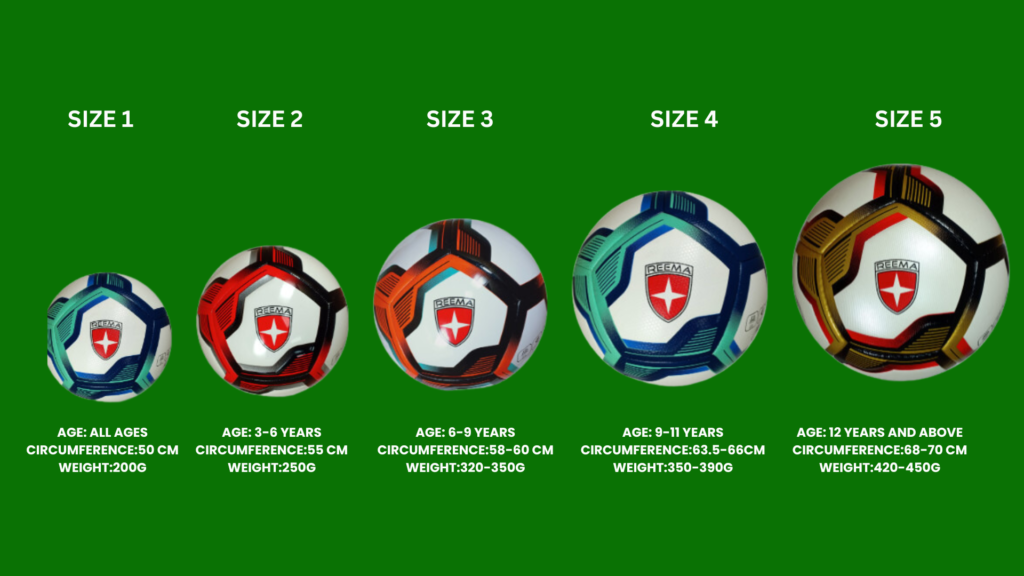
Football Size Information
Size 4 Football
| Usage | Benefits |
|---|---|
|
|
Size 3 Football
| Usage | Benefits |
|---|---|
|
|
Specific Training Scenarios
| Usage | Benefits |
|---|---|
|
|
- Size 4: While primarily for youth, Size 4 balls can be beneficial in adult training sessions to focus on specific skills like dribbling, passing, and shooting in a controlled environment. They are lighter and easier to handle, allowing players to refine their techniques.
- Size 3: Generally not used in adult settings, Size 3 balls may be used for very young players or in specific training scenarios aimed at developing fundamental skills.
Importance of Proper Football Size
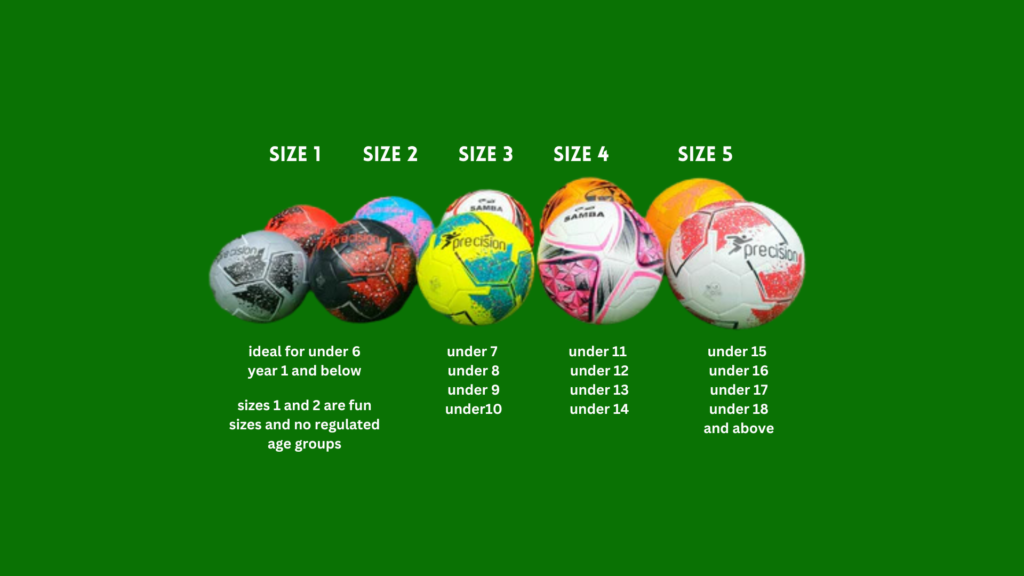
Football Size Information
Performance Enhancement
| Aspect | Description |
|---|---|
| Optimal Control | Ensures better control and responsiveness, aiding skill execution. |
| Improved Accuracy | Size and weight affect flight path and bounce, enhancing predictability. |
| Enhanced Technique | Helps refine skills like dribbling and shooting. |
Safety Considerations
| Aspect | Description |
|---|---|
| Injury Prevention | Correct size reduces mishandling and injury risks. |
| Proper Handling | Develops strength and coordination, minimizing injury chances. |
| Consistent Conditions | Prepares players for real game scenarios. |
Skill Development
| Aspect | Description |
|---|---|
| Appropriate Challenges | Different sizes help focus on specific skills. |
| Realistic Training | Prepares players for actual match conditions. |
| Confidence Building | Boosts confidence and enjoyment based on age and skill level. |
Consistency and Fairness
| Aspect | Description |
|---|---|
| Standardization | Ensures consistency and fair competition across all levels. |
| Governing Body Regulations | Mandated by FIFA to maintain game integrity. |
| Enjoyment and Flow | Enhances experience and teamwork focus. |
Performance: Proper ball size will indeed enhance the levels of control, accuracy, and indeed overall performance. Some of the features that may describe the different characteristics of the ball include nine measurements regarding the weight and the size of the ball.
These help in determining such aspects which include the expected bouncing of the ball on the ground and expected movements of the players feet in relation to the ball.
Safety: Using the correct size reduces the risk of injury. A ball that is too small or too large can be difficult to handle, leading to poor playing conditions and potential accidents.
Training: Different sizes can be used strategically in training to help players improve specific skills. That is the reason why coaches are encouraged to use Size 4 ball for their players since it enhances control when using the ball while playing than Size 5 ball.
Consistency: In other words, it helps the players to practice with the standard defined ball size in a manner that they should be ready to encounter the same as soon as they join Argentine Soccer leagues.
Conclusion
In particular, the football player has to limit himself to Size 5 football norm for the adult players only Ensuring that the football meets the official measurements not only enhances the playing experience but also contributes to the overall quality and safety of the game. Coaches and players alike should prioritize using the correct size football to foster skill development, ensure safety, and promote fair play on the pitch.
Also Read: Size Of Football Ground In Meters

Leave a Reply